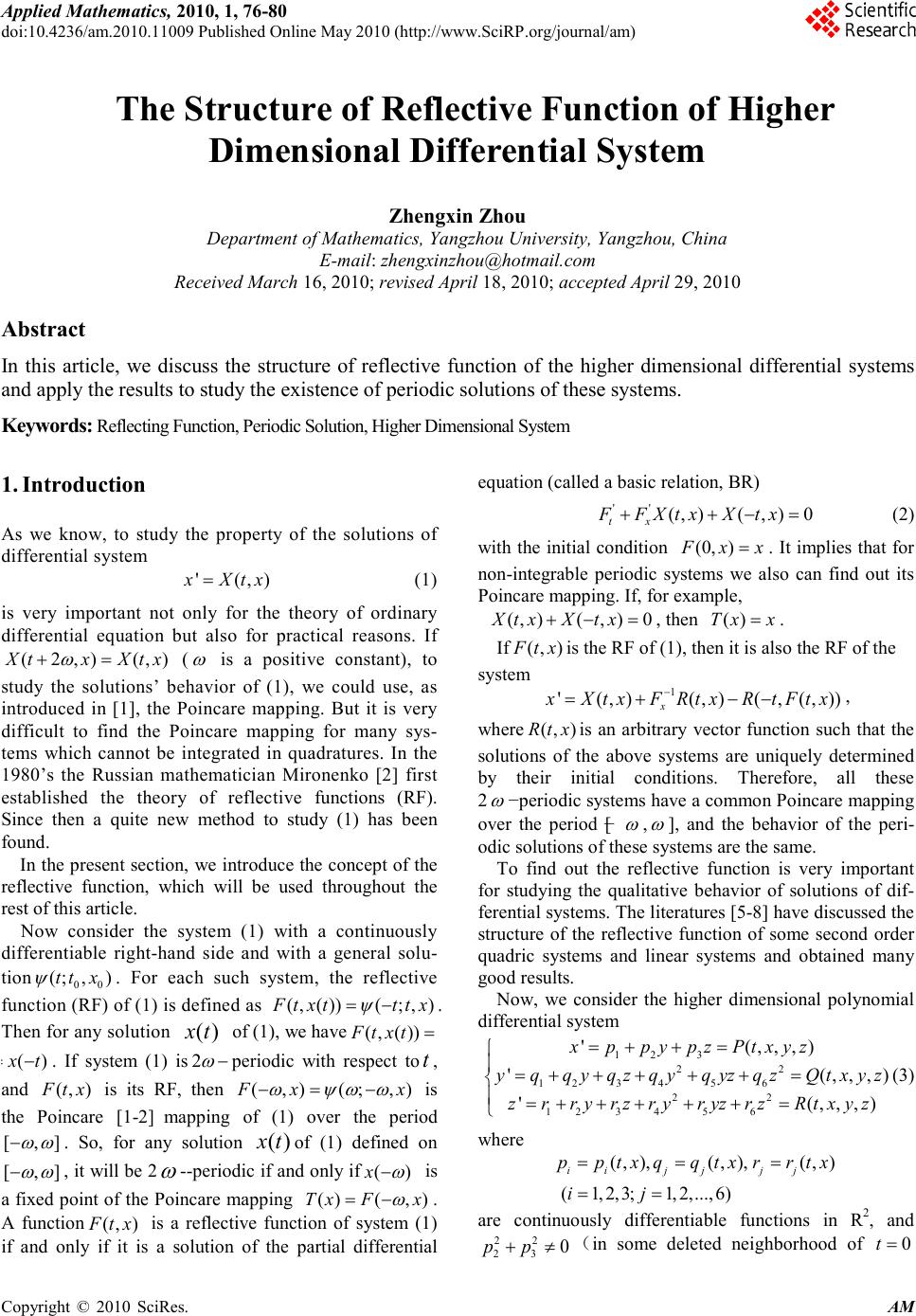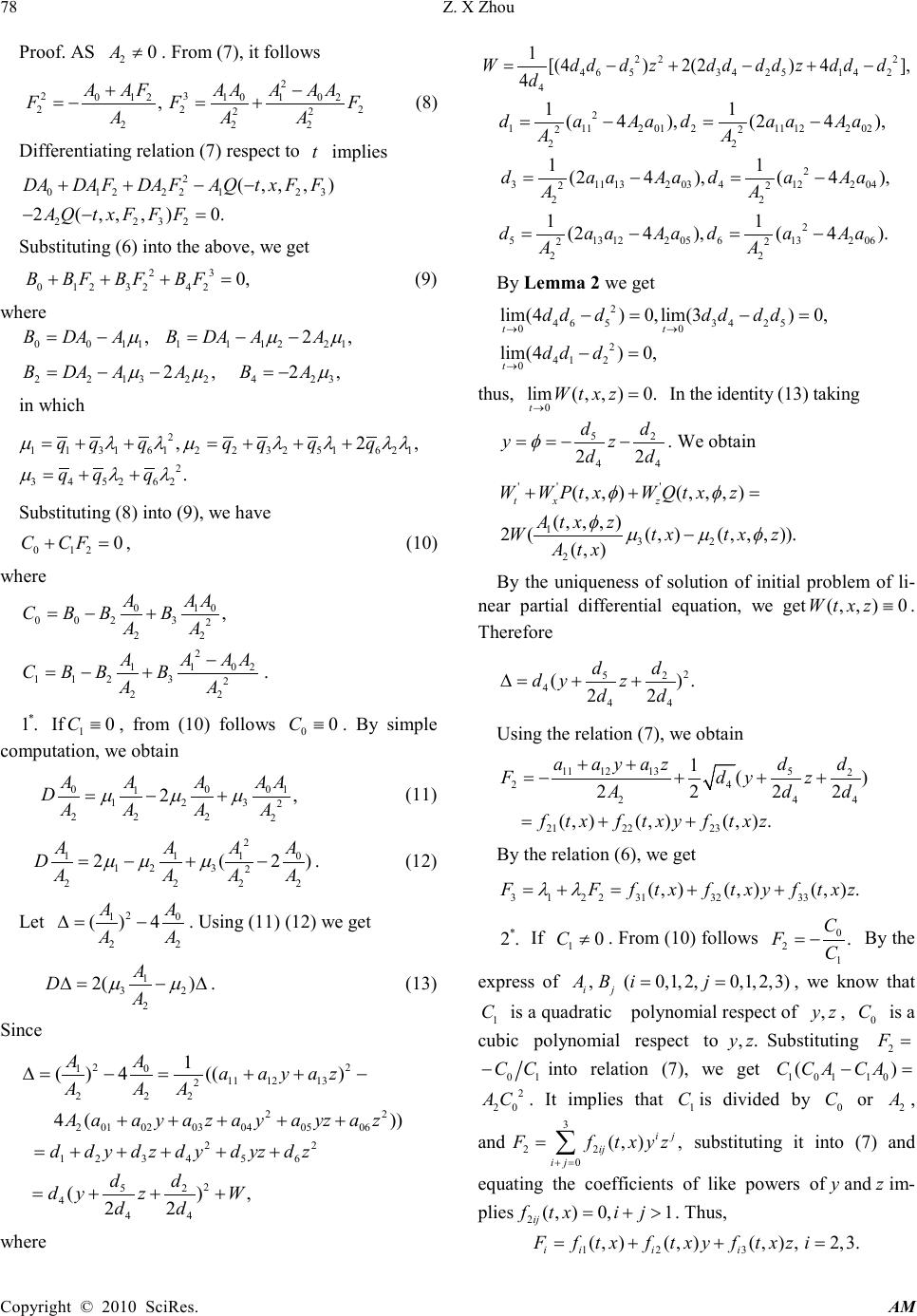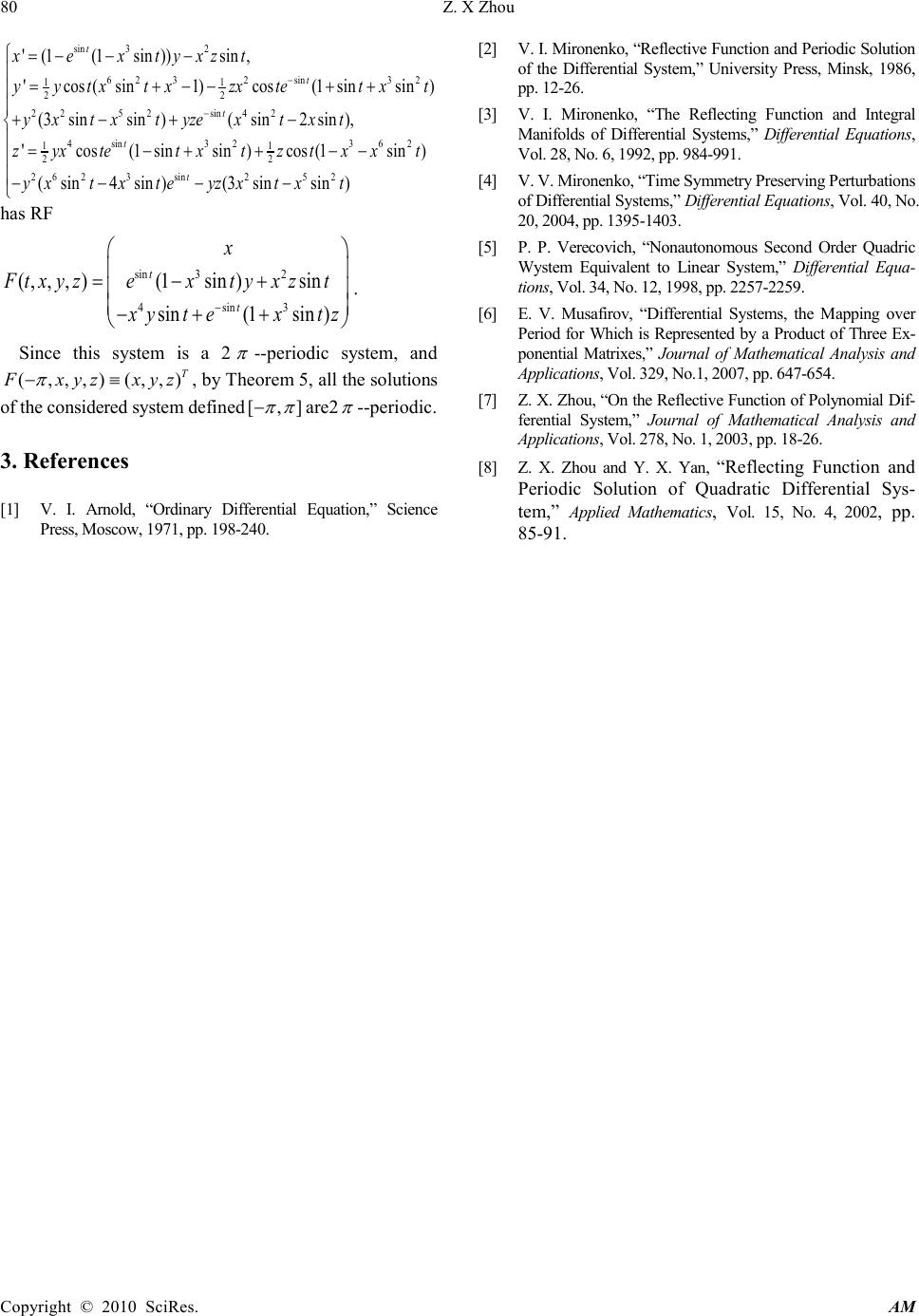 Applied Mathematics, 2010, 1, 76-80 doi:10.4236/am.2010.11009 Published Online May 2010 (http://www.SciRP.org/journal/am) Copyright © 2010 SciRes. AM The Structure of Reflective Function of Higher Dimensional Differential System Zhengxin Zhou Department of Mathematics, Yangzhou University, Yangzhou, China E-mail: zhengxinzhou@hotmail.com Received March 16, 2010; revised April 18, 2010; accepted April 29, 2010 Abstract In this article, we discuss the structure of reflective function of the higher dimensional differential systems and apply the results to study the existence of periodic solutions of these systems. Keywords: Reflecting Function, Periodic Solution, Higher Dimensional System 1. Introduction As we know, to study the property of the solutions of differential system (1) is very important not only for the theory of ordinary differential equation but also for practical reasons. If ( 2,)(,)Xtx Xtx ω += ( is a positive constant), to study the solutions’ behavior of (1), we could use, as introduced in [1], the Poincare mapping. But it is very difficult to find the Poincar e mapping for many sys- tems which cannot be integrated in quadratures. In the 1980’s the Russian mathematician Mironenko [2] first established the theory of reflective functions (RF). Since then a quite new method to study (1) has been found. In the present section, we introduce the concept of the reflective function, which will be used throughout the rest of this article. Now consider the system (1) with a continuously differentiable right-hand side and with a general solu- tion . For each such system, the reflective function (RF) of (1) is defined as . Then for any solution of (1), we have( ,( ))Ft xt= . If system (1) is periodic with respect to , and (, )Ftx is its RF, then (,)(;,)Fx x ωψω ω −= − is the Poincare [1-2] mapping of (1) over the period . So, for any solution of (1) defined on , it will be 2 --periodic if and only if is a fixed point of the Poincare mapping . A function is a reflective function of system (1) if and only if it is a solution of the partial differential equation (called a basic relation, BR) '' (,)( ,)0 tx FFXtxX tx++− = (2) with the initial condition (0, ) =. It implies that for non-integrable periodic systems we also can find out its Poincare mapping. If, for example, , then ()Tx x=. If (, )Ftxis the RF of (1), then it is also the RF of the system 1 '(, )(, )(,(, )) x xXtxF RtxRtFtx − = +−− , whe re is an arbitrary vector function such that the solutions of the above systems are uniquely determined by their initial conditions. Therefore, all these 2 −periodic systems have a common Poincare mapping over the period [− , ], and the behavior of the peri- odic solutions of these systems are the same. To find out the reflective function is very important for studying the qualitative behavior of solutions of dif- ferential systems. The literatures [5-8] have discussed the structure of the reflective function of some second order quadric systems and linear systems and obtained many good results. Now, we consider the higher dimensional polynomial differential system 12 3 22 123 456 22 123 456 '(, ,, ) '(, ,, ) '(, ,, ) xppypzPt x y z yqqyqz qyqyz qzQtxyz zrryrz ryryz rzRtxyz =++= =++++ += =++++ += (3) where (, ),(,),(, ) (1, 2,3;1, 2,..., 6) i ij jjj pp txqqtxrr tx ij == = = = are continuously differentiable functions in R2, and (in some deleted neighborhood of  Z. X Zh o u Copyright © 2010 SciR es. AM and | | being small enough, is different from zero), and there exists a unique solution for the initial value problem of (3). And suppose that 123 (, ,, )((, ,, ),(,,,),(, ,, )) T FtxyzFtxyzFtxyz Ftxyz= is the RF of (3). In this paper, we will discuss the structure of when . At the same time, we obtain the good results that 12 3 (, , , )(,)(,)(, )(2,3) iii i Ftxyzftxftxyftxzi=++ = . The obtained results are used for research of problems of existence of periodic solution of the system (3) and es- tablish the sufficient conditions under which the first component of the solution of (3) is even function. In the following, we will denote (, );(, );(, );(, ,,), iijjjji i pptx qqtxrrtx FFtxyz=− =−== . The notation means that, in some deleted neighborhood of and | | being small enough, is different from zero, (, ,, )(, ,, )(,,, ). AA AA DAPtxyz QtxyzRtxyz tx yz ∂∂ ∂ ∂ =+++ ∂∂ ∂∂ 2. Main Results Without loss of generality, we suppose that (, )ftx x=. Otherwise, we take the tra nsformation . Now, let’s consider the system (3) Lemma 1. For the system (3), suppose that . The n (4) Proof. Using the relation (2), we get 23 (,,,)(,,,)0PtxyzPtxF F+− = , i.e. 11232233 0pppypzpF pF+++++= . (5) Putting , we get 12 3 (0, )(0,)(0, )0,,,pxpxypxzxyz++ ≡∀ . It implies that the relation (4) is valid. In the following discussion, we always assume (4) holds without further mention. Case 1. . From (5), we get , (6) where 3 112 111 1213 3 33 2 2 , . y zyz p pp p p λλλ λ λ = − Differentiating relation (6) respect to implies , (7) whe re 2 0121113231626 01 0203040506 ( )() ; A Dqrrqrq aay azayayz az λλλ λλλ = − ++−+− =++++ + 1222223231 525 1 2626111213 ( )( ) 2( ); ADqrr qr q rqaay az λλλλλ λ λλ λ = − ++−+− +− =++ ; 2 222442 5252626 ( ,)()(),AA txqrrqrq λ λλλλ ==− ++−+− In which '' 0111111 121 131121 2 1132362 611 ()() ; tx apqrrq rqrq λλλ λλ λ λλλ = ++++−+ +−+− '' ' 0212122121122 132 1232362611 12 () 2(); txx appqr rq rq λλλλ λ λλλ λλ =+++ ++ +− +− '' ' 0313113133123 133 1332362611 13 () 2(); tx x ap pqr rq rq λλλλ λ λλλ λλ =+++++ +− +− '2 04122 124 13462612 ( ); x apqrrq λλ λλλ =+++− '' 0512313212513 56261213 2() ; xx appq rrq λλλλλλλ =++++− '2 0613312 613662 613 ( ); x apqrrq λλ λλλ =+++− '' 1122122 2232 3 1152 56262 11 () () 2(); tx apr qr q rq rq λλλ λλ λλλ λλ = ++−+−+ +− +− ' 12221252 562 62 12 () 2(); x aprq rq λλλλ λλ =+−+− ' 132 313525626 213 () 2(); x aprqrq λλλλ λλ =+− +− 3 11 2 1112 13 3 33 , ,. p pp p p pp λ λλ + =− =−=− Lemma 2.Le t and 0 02 lim(1, 2,...,6) i t ai A → = exist. Then 0 0 lim0(1, 3, 6), j t j A → = = 04 1205 13 lim1, lim0. aa aa Proof. Using the relation (7), we have 22 01 0203040506 02 lim t aay azayayz az A → ++++ ++ 2 11 1213 2 limlim 0, aay az A ++ As , it follows that the results of Lemma 2 are true. Theorem 1. Let the conditions of Lemma 1 and Lemma 2 satisfy and . Then 123 (, )(, )(, )(2,3). ii ii Ff txftxyftxzi=++ =  Z. X Zhou Copyright © 2010 SciR es. AM Proof. AS 20A≠. From (7), it follows 2 23 0121010 2 22 2 22 222 , AAFAAAA A FF F AAA +− =−=+ (8) Differentiating relation (7) respect to implies 2 0122212 3 2 232 ( ,,,) 2(, ,,)0. DADAFDAFAQtxFF AQtx FFF + +−− −− = Substituting (6) into the above, we get 23 0 12 3242 0,BBF BFBF++ += (9) whe re 00 11111221 , 2,BDAABDA AA µ µµ =− =−− 22 1322423 2, 2, µµ µ =−−=− in which 2 1131612232 51621 2 34 52 62 , 2, . qq qqqqq qq q µλλ µλλλλ µ λλ =++ =+++ =++ Substituting (8) into (9), we have 012 0C CF , (10) whe re 0 10 0 023 2 22 2 1 02 1 1 1232 22 , . A AA C BBB AA A AA A C BBB AA =−+ − =−+ If , from (10) follows 00C≡. By simple computation, we obtain 00 01 1 1 23 2 2222 2, AA AA A DAAA A µ µµ =−+ (11) 2 0 1 11 12 3 2 22 2 2 2( 2) A A AA DAA A A µµ µ =−+ − . (12) Let . Using (11) (12) we get 1 2 2( ) A DA ∆=−∆. (13) Since 22 0 1 11 1213 2 22 2 22 2 010203040506 22 123 456 2 52 4 44 1 ( )4(() 4 ()) ( ), 22 A Aaay az AA A Aaay azayayz az ddy dz dydyzdz dd dy zW dd ∆=−=++− ++++ + =++++ + =++ + whe re 22 2 4653425 142 4 1[(4)2(2) 4], 4 Wdddzdd ddzdd d d =−+−+− 2 1112 01211122 02 2 311132034122 04 2 513122 05613206 (4),(24 ), (24),(4 ), (24 ),(4 ). daAadaaAa da aAadaAa da aAadaAa By Lemma 2 we get 2 46 534 25 00 2 412 0 lim(4)0,lim(3)0, lim(4) 0, tt t dd ddddd dd d →→ → −=− = −= thus, 0 lim(,,)0. tWtxz →= In the identity (13) taking 52 dd φ . We obtain '' ' 1 32 2 (, , )(,, ,) (, ,, ) 2(( ,)( ,,,)). (, ) tx z W WPtxWQtxz Atx z Wtxtx z A tx φφ φµ µφ ++ = − By the uniqueness of solution of initial problem of li- near partial differential equation, we get . Therefore 2 52 4 ( ). dd dy z ∆= ++ Using the relation (7), we obtain 11 121352 24 2 44 21 2223 1() 2222 (, )(, )(, ). aay azdd Fdy z A dd f txftxyftxz ++ =−+ ++ =++ By the relation (6), we get 3122313233 (, )(, )(, ).FFf txftxyftxz λλ =+=++ If 10C≠. From (10) follows 0 2 1 . C FC = − By the express of ,(0,1, 2,0,1,2, 3) ij AB ij= = , we know that 1 C is a quadratic polynomial r espect of , is a cubic polynomial respect to Substituting 2 F= −into relation (7), we get 1 0110 C CACA . It implies that 1 Cis divided by or , and 3 22 0 (, ), ij ij Fftx yz += =∑ substituti ng it into (7) and equating the coefficients of like powers of and im- plies . Thus, 123 (, )(, )(, ),2,3. ii ii Fftxftxyftxz i=++ =  Z. X Zh o u Copyright © 2010 SciR es. AM Summarizing the above, the proof is completed. Obviously, from the relation (7) implies Theorem 2. Let 1 21 ,(0,)0(1,2, 3),0,0 i F xpxiAA====≠. The n 1 22 001 0203040506 2 111 1213 3 22 , . Aaay az ayayz az FAaay az FF λλ ++++ + =−=− ++ = + Case 2. ( ,)0,0 . Applying identity (5) yields 112 2 12 22 , pp p F yy pp ζζ + =− −=+ where Differentiating this identity respect to implies , whe re 2 0121 2243 01 0203040506 () , MDyq qFqF mmy mzmymyz mz ζζ =+ ++ += ++++ + 1352111226 ,,MqqFmm y Mq=+=+ = '' 2 01111211 21 41 ; tx mpqqq q ζζζζ ζ =+ ++++ ''' 02122122 222412 2; x xt mp pqq q ζζζζζζζ =+++++ '2 04222442; x mp qq ζζ ζ = ++ 032 305250626 113511252 ,,, ,. m qm qmq m qqmq ζζζ ζζ == = =+= Similarly, we obtain the following conc l usi on: Lemma 3. Let 0,0, 0, and 0 06 lim(1, 2,..., 5) i t mi q → = and 1 02 lim t p p → exist. Then 011 2 0 00 6 22 lim0(1, 2, 4), lim0,lim1 j t tt mpp p j q pp → →→ + ==== − 03 1105126 00 0 6 66 lim0, lim0,lim1. tt t mm mmq q qq →→ → ++ === − Theorem 3. Let the conditions of Lemma 1 and Lemma 3 satisfy. Then 21 2 3 313233 (, )(, ), (, )(, )(, ). F txtxy Ff txftxyf txz ζζ = + Theorem 4. Let 22 11 121 0, i m mFx +≠= , Then 21 2 2 01 02030405 3 11 12 (, )(, ), . F txtxy mmy mzmymyz Fm my ζζ = + ++++ = −+ Theorem 5. For the system (3), if the following con- ditions satisfy 112 213 31222223 32 0, 0,p ppfpfppfpf+++= ++= 32233 332131 0,(0, )0,(0, )0,p pfpffxfx++== = '' 222321 31 21 21 1 11 '' 23332131 31 31 ( ,,,) ( ,,,) 0, tx tx ffQ txff ff pqr ffRtxff ff − ++ ++ − = ''' ''' 2223222321 221 3 1 ''' ''' 3233323331 232 3 '' 22232 3 '' 32332 3( ,,0,0) 0, tt xxx x tt xxx x yz yz tx fffffpfp p fffffp fp ff qqQQ f f rrRR '' 22 2346 22223 3 '' 32 334 6 32233 3 22 4622 23 523 33 5 22 23 22 462223 52333 5 32 33 0, xx xx ff qq fp fp f f rr fp fp qqffqffq ff rrffrffr ff '' 22 235 3 22 23 '' 32 33 5 2 32 33 4 22 23522 3323326 32 33 4 22 23522 332332632 33 2()2 0, 2 ()2 xx xx ffq p ff ffr p ff qffqffffqff rff rffffrff + ++ = + ++ 22 232223 22 23 32 333233 32 33 (0, )(0, )10 . (0, )(0, )01 f ffxfx ff f ffxfx ff = = The n 21 2222 31 3233 x Fffyfz ffyfz =++ ++ is the RF of system (3). Besides this, if the system (3) is --periodic with re- spect to , then its solution define d on the interval with initial condition ( (), ω − ( ),())yz − −= is 2 --periodic if and only if F − Proof. By checkout of the BR it is proved that the function 212223 313233 (,, ) T F xffyfzffyfz= ++++ is the RF of system (3). At this moment, the Poincare map- ping of periodic system (3) is (,,)Txyz =( ,,,F xy ω − )z. By the previous introduction the assertions of the present theorem is hold. The proof is finished. Under the hypotheses of Theorem 5, the first compo- nent of solution of system (3) is even function. Example: Differential system  Z. X Zhou Copyright © 2010 SciR es. AM sin 32 6 232sin3 2 11 22 2252sin 42 4sin3236 2 11 22 26 2 '(1(1sin ))sin , 'cos (sin1)cos(1sinsin) (3sinsin)(sin2sin ), 'cos(1sinsin )cos(1sin ) ( sin t t t t xext yxzt yy txtxzxtetxt yxt xtyzextxt zyxtet xtztxxt yx t − − =−− − =+−−++ + −+− =− ++−− − 3sin25 2 4sin)(3sinsin) t xteyzxtxt − −− has RF sin 32 4sin 3 ( ,,,)(1sin)sin sin(1sin ) t t x Ftxyzexty xzt xyt extz − =−+ − ++ . Since this system is a 2 --periodic system, and , by Theorem 5, all the solutions of the considered system defined are2 --periodic. 3. References [1] V. I. Arnold, “Ordinary Differential Equation,” Science Press, Moscow, 1971, pp. 198-240. [2] V. I. Mironenko, “Reflective Function and Periodic Solution of the Differential System,” University Press, Minsk, 1986, pp. 12-26. [3] V. I. Mironenko, “The Reflecting Function and Integral Manifolds of Differential Systems,” Differential Equations, Vol. 28, No. 6, 1992, pp. 984-991. [4] V. V. Mironenko, “Time Symmetry Preserving Perturbations of Differential Systems,” Differential Equations, Vol. 40, No. 20, 2004, pp. 1395-1403. [5] P. P. Verecovich, “Nonautonomous Second Order Quadric Wystem Equivalent to Linear System,” Differential Equa- tions, Vol. 34, No. 12, 1998, pp. 2257-2259. [6] E. V. Musafirov, “Differential Systems, the Mapping over Period for Which is Represented by a Product of Three Ex- ponential Matrixes,” Journal of Mathematical Analysis and Applications, Vol. 329, No.1, 2007, pp. 647-654. [7] Z. X. Zhou, “On the Reflective Function of Polynomial Dif- ferential System,” Journal of Mathematical Analysis and Applications, Vol. 278, No. 1, 2003, pp. 18-26. [8] Z. X. Zhou and Y. X. Yan, “Reflecting Function and Periodic Solution of Quadratic Differential Sys- tem,” Applied Mathematics, Vol. 15, No. 4, 2002, pp. 85-91.
|